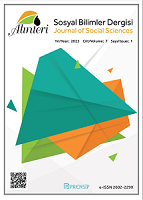Kastamonu’da Kurt ve Geyikler ile İlgili İnanışlar (Orhun’dan Kastamonu’ya)
Beliefs About Wolf and Deer in Kastamonu (from Orhun to Kastamonu)
Author(s): Ahmet Bekaroğlu, Halit ÖzdenSubject(s): Customs / Folklore, Cultural Anthropology / Ethnology, Culture and social structure
Published by: Kastamonu Üniversitesi
Keywords: Alperens; Gökbörü; Gray wolves; Kastamonu; Wolf and deer beliefs;
Summary/Abstract: The Turks, who spread from Turkistan to Anatolia and from Anatolia to other countries and continents with the spirit of conquest, have made nature and the animals living in it the nature an inseparable part of their daily lives, both in their migration movements and in the places where they have settled. Calm-tempered animals such as deer, which are at a trainable level, were used in freight transportation, especially in the first conquest periods of Anatolia; it was used extensively in the construction of mosques, complexes, inns and baths. The first Alperens who came to Kastamonu also used deer. It is possible to see antlers as an example of fidelity at the entrance of many shrines in Kastamonu, where the narrations about deer are told. Wolves have had an important place in the lives of Turks in the historical process. The leading wolves to whom value is attributed are Gökbörü and Bozkurt (Gray wolf). These two types were valued in connection with power and prestige. In the article, the extension of the wolf and deer beliefs from past to present in Kastamonu was investigated by scanning the articles in the literature with field research, interviews with source people, on-site detection and archiving. The beliefs about wolves and deer that still persist in Kastamonu have been compiled and the narratives have been evaluated to examine the reality of these beliefs and whether they still continue or not. In the ancient Turkish city of Kastamonu, the views and opinions about these beliefs, which came from the ancestral homeland, were expressed based on the narratives and visuals obtained through field research, especially the source people who are still alive.
Journal: Alınteri Sosyal Bilimler Dergisi
- Issue Year: 7/2023
- Issue No: 1
- Page Range: 1-18
- Page Count: 18
- Language: Turkish

